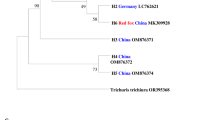Abstract
Population-S small strongyles have been studied since 1974 in central Kentucky in a closed Shetland pony breeding herd. The ponies were treated approximately every 8 weeks with cambendazole (1974–1978), oxibendazole (OBZ) (1978–1992), or pyrantel pamoate (PRT) (1992–1999). Small strongyles in the ponies have shown resistance to these compounds in field and critical tests. One purpose of this presentation was to compare different parameters for determination of effects on the small strongyle species in ponies after treatment, mainly with OBZ or PRT, from data in critical tests (n=112). Also, the objective was to report on relative changes in the composition of species of small strongyles during the period 1977 through 1999. The following entities were compared to evaluate the effect of OBZ- or PRT-treatment on the small strongyles: (1) numbers of specimens with eggs in utero—there were less gravid worms passed in the feces than recovered at necropsy for OBZ but the numbers of gravid worms were similar in both categories for PRT, (2) pre- and posttreatment counts of eggs per gram of feces (EPGs) and larvae per gram of feces (LPGs)—the reductions were greater for the counts of EPGs than LPGs for OBZ but not for PRT, and (3) pre- and posttreatment counts of EPGs versus % of worms removed—reductions of the former were greater than the latter for both compounds. As shown from data in this study, reduction of EPG counts post treatment indicated much greater drug activity than was actually demonstrated by removal of worms. One evident factor was the value of doing critical tests to verify posttreatment counts of EPGs as indicators of anthelmintic activity. Twenty-eight species of small strongyles were found. For the 20 most prevalent species in the study, two decreased, five remained unchanged, three increased and then became stationary, five increased but then decreased, and five increased progressively. Numbers of small strongyles were highest in 1987 and 1999.


Similar content being viewed by others
References
Dimock WW (1949) The two-gram daily dose of phenothiazine for strongylosis of the horse. Vet Med 44:99–102
Drudge JH, Lyons ET (1977) Methods in the evaluation of antiparasitic drugs in the horse. Am J Vet Res 38:1581–1586
Drudge JH, Lyons ET, Swerczek TW, Tolliver SC (1983) Cambendazole for strongyle control in a pony band: selection of a drug-resistant population of small strongyles and teratologic implications. Am J Vet Res 44:110–114
Drudge JH, Lyons ET, Tolliver SC, Swerczek TW (1985) Use of oxibendazole for control of cambendazole-resistant small strongyles in a band of ponies: a 6-year study. Am J Vet Res 46:2507–2511
Lyons ET, Drudge JH, Tolliver SC, Swerczek TW, Stamper S, Granstrom DE (1994) Control of cambendazole-resistant small strongyles (Population S) with oxibendazole in a pony band: an 8-year field test (1984–1992). Vet Parasitol 52:271–277
Lyons ET, Tolliver SC, Drudge JH, Stamper S, Swerczek TW, Granstrom DE (1996a). Critical test evaluation (1977–1992) of drug efficacy against endoparasites featuring benzimidazole-resistant small strongyles (Population S) in Shetland ponies. Vet Parasitol 66:67–73
Lyons ET, Tolliver SC, Drudge JH, Stamper S, Swerczek TW, Granstrom DE (1996b) A study (1977–1992) of population dynamics of endoparasites featuring benzimidazole-resistant small strongyles (Population S) in Shetland ponies. Vet Parasitol 66:76–86
Lyons ET, Tolliver SC, Drudge JH, Collins SS, Swerczek TW (2001) Continuance of studies on Population S benzimidazole-resistant small strongyles in a Shetland pony herd in Kentucky: effect of pyrantel pamoate (1992–1999). Vet Parasitol 94:247–256
Moskey HE, Harwood PD (1941) Methods of evaluating the efficacy of anthelmintics. Am J Vet Res 2:55–59
Ogbourne CP (1978) Pathogenesis of cyathostome (Trichonema) infections of the horse: a review. Commonwealth Institute of Helminthology, Commonwealth Agricultural Bureaux of the United Kingdom, Misc Publ 5, pp 1–25
Reinemeyer CR (1986) Small strongyles. Recent Advances. Vet Clin North Am Equine Pract 2:281–312
Todd AC, Hansen MF, Wyant ZN, Kelley GW, Crowdus DH (1950) Continuous low-level versus periodic phenothiazine therapy for thoroughbred yearlings. Ky Agric Exp Stn Bull 545
Acknowledgements
This investigation (paper no. 03-14-046) was carried out in connection with a project of the Kentucky Agricultural Experiment Station and is published with the approval of the director. Appreciation is expressed to Sharon C. Tolliver for identification of the small strongyle species in this study.
Author information
Authors and Affiliations
Corresponding author
Rights and permissions
About this article
Cite this article
Lyons, E. Population-S benzimidazole- and tetrahydropyrimidine-resistant small strongyles in a pony herd in Kentucky (1977–1999): effects of anthelmintic treatment on the parasites as determined in critical tests. Parasitol Res 91, 407–411 (2003). https://doi.org/10.1007/s00436-003-0983-6
Received:
Accepted:
Published:
Issue Date:
DOI: https://doi.org/10.1007/s00436-003-0983-6




